Create a campaign
Creating a campaign has four steps: entering campaign details, selecting items to promote, choosing the target browse pages and keywords where items will be promoted, and reviewing the campaign details and budget.
Step 1: Enter campaign details
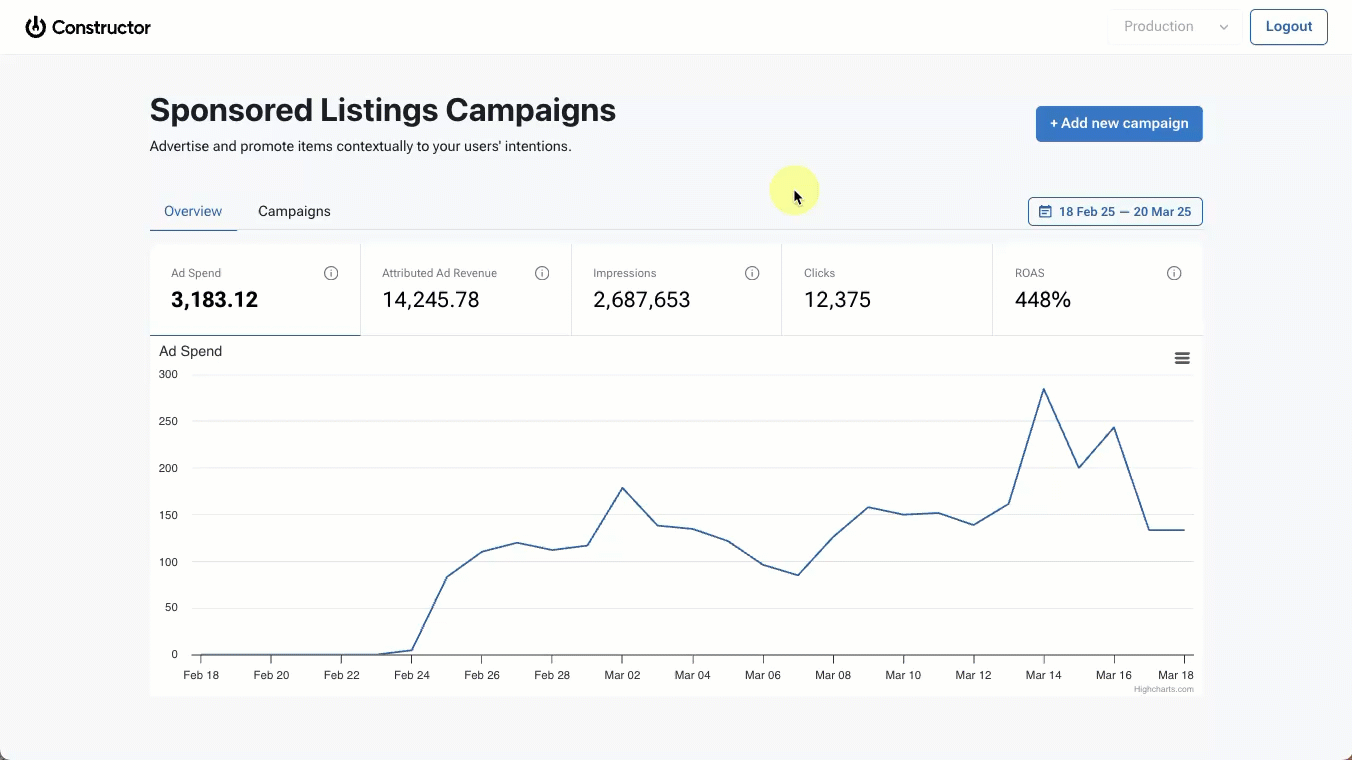
- Select + Add New Campaign in the top-right corner of the Sponsored Listings dashboard.
- On the left side of the page, enter a Campaign name in the field provided. This name will help you identify the campaign in your main campaign listing.
- Choose a Start Date and End Date for the campaign. Clicking into either field expands a calendar picker, allowing you to select the desired date.
- The Start Date defaults to the current date, but you can change it to a future date if you are scheduling a future campaign.
- The End Date is optional but recommended for time-boxed campaigns.
Step 2: Select items to promote
When selecting items to promote, you can search for them by item name or ID, scroll through the listing, by specific browse pages, or by uploading an item CSV.
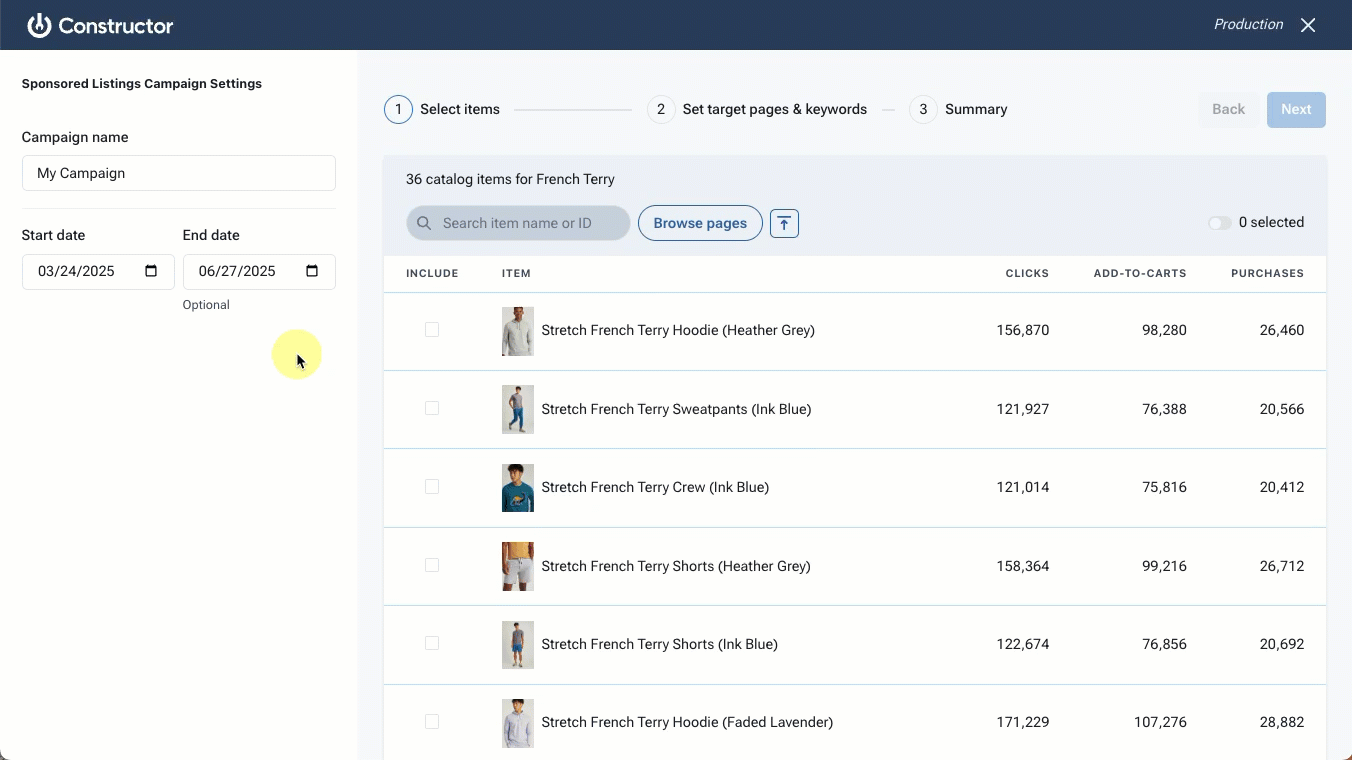
- To search for a specific item, enter the item name or item ID in the search field at the top of the item listing.
- To choose items by browse page, select the Browse Pages filter at the top of the item listing.
- A pop-up with a drop-down list of available browse pages will appear. Choose the browse page(s) whose items you wish to view by selecting the checkmark to the left of each browse page name, then select Apply.
- Note: Selecting a browse page during this step simply helps you choose which items to sponsor. It has no impact on the actual page. That step comes later.
- To upload a CSV of items to promote, select the upload icon at the top of the item listing.
- You will automatically be prompted to choose a file from your device.
- If desired, you can select Download File Template to download a template file to your device.
- When you locate an item to promote, select the checkbox to the left of the item name.
- Once you’ve selected all items you wish to promote, select Next in the top-right corner of the page.
How many items should I add to a campaign?Ultimately, the number of items to include in a campaign is up to you. For example, a Retailer set up each browse and search page to contain 3 sponsored positions, but there are benefits to including more than 3 items in a campaign.
During the next step, you’ll see a list of browse pages and search keywords that include at least on of the items you select. If you select only 3 products, there’s a chance some browse pages and search keywords would include only 1 or 2 items, so not all positions will be occupied with your selected products if they win.
Having more items in a campaign gives Constructor’s algorithm a broader choice of items to show a user. As results are personalized, the more items in the campaign, the higher the chance one of the items will be attractive to a user and the higher ROAS for the campaign there may be.
Step 3: Choose target browse pages, keywords, and recommendation pods
When creating a campaign, you can choose which browse pages, search keywords, and/or recommendation pods you wish to target. However, you can only choose from pages, keywords, and/or pods where the selected items would appear organically.
If you selected more than one item for a campaign, then items will only appear for the pages, keywords, and/or pods where they would organically appear. For example, if a campaign included a table and a chair, the table would not appear as a sponsored item for the search keyword "chair" as it would not appear in an organic search for chairs.
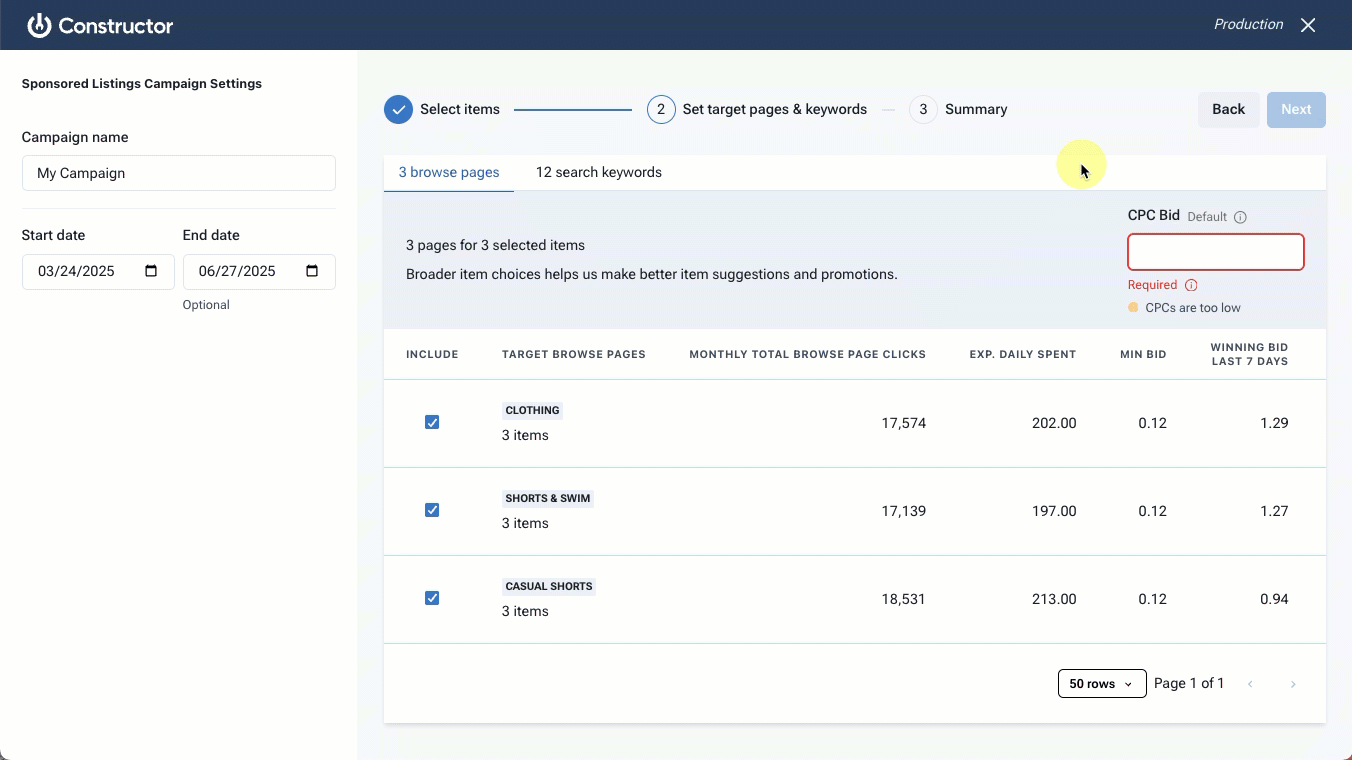
Browse pages
You will have a set number of browse pages to choose from. Again, these are browse pages where the selected items would organically appear.
- Select the Browse Pages tab at the top of the page.
- To target a specific browse page, ensure you select the checkbox to the left of the page name.
- Next, define the cost per click (CPC) bid. You can do this in two places:
- Default CPC: You will need to set the default CPC for all selected browse pages by entering that amount in the CPC Bid field in the top-right corner of the page. This is the CPC used for all pages unless you’ve defined the CPC for a specific page.
- Specific page CPC: You can set the CPC for a specific browse page by entering that amount in the CPC Bid field on the right side of the browse page row. This amount will be used instead of the default CPC amount. This allows you to remain competitive for top browse pages.
Search keywords
A note on search query keywordsBy default, all selected search query results pages within the campaign adhere to an exact match logic. For example, if you select "Garden Sofa" as a search keyword, then your selected items will show for that keyword specifically, and not the general "Sofa" keyword. This allows the system to maintain target precision for only "Garden Sofa" results.
You will have a set number of search keywords to choose from. Again, these are search keywords for which the selected items would organically appear as results.
- Select the Search Keywords tab at the top of the page.
- To target a specific search keyword, ensure you select the checkbox to the left of the keyword name.
- Next, define the cost per click (CPC) bid. You can do this in two places:
- Default CPC. You will need to set the default CPC for all selected keywords by entering that amount in the CPC Bid field in the top-right corner of the page. This is the CPC used for all keywords unless you’ve defined the CPC for a specific keyword.
- Specific keyword CPC. You can set the CPC for a specific keyword by entering that amount in the CPC Bid field on the right side of the keyword row. This amount will be used instead of the default CPC amount. This allows you to remain competitive for top search keywords.
Recommendation pods
You will have a set of recommendation pods to choose from. Again, these are pods where the selected items would organically appear.
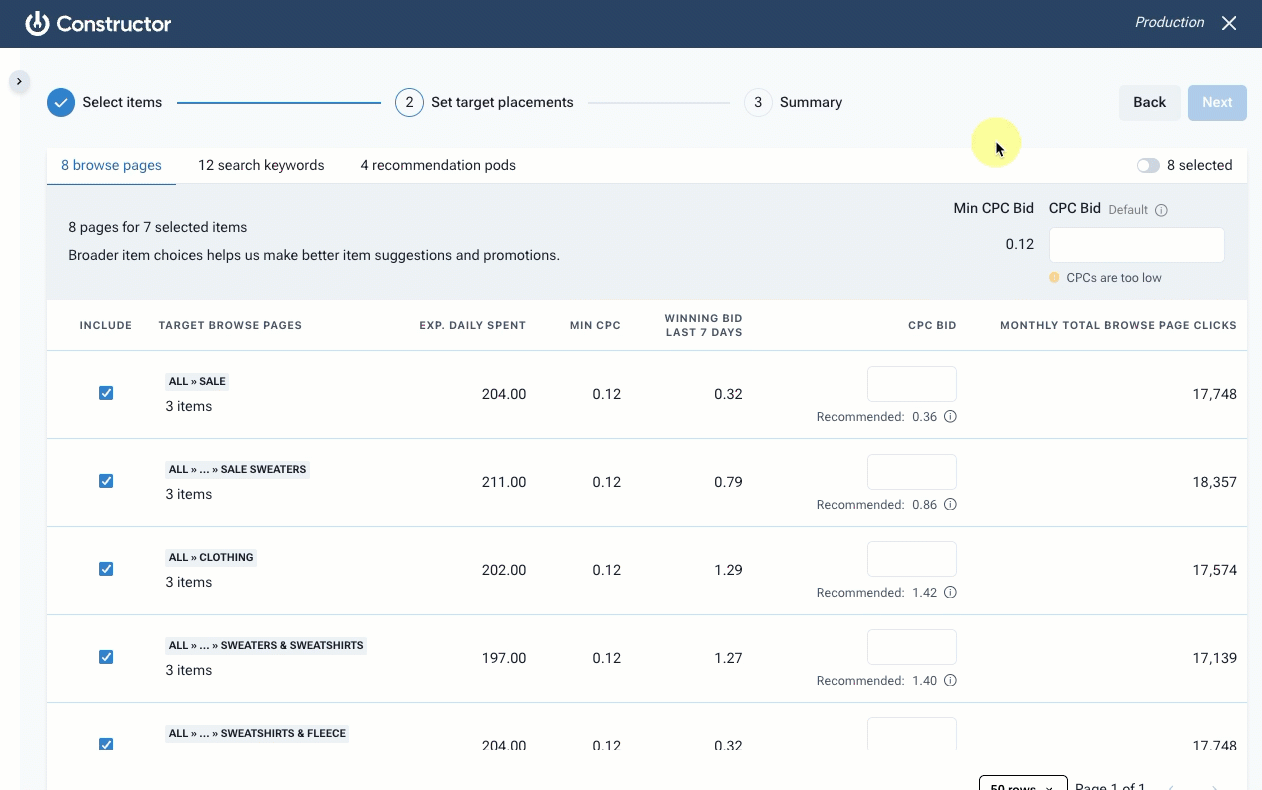
- Select the Recommendation Pods tab at the top of the page.
- To target a specific pod, ensure you select the checkbox to the left of the pod name.
- Next, define the cost per click (CPC) bid. You can do this in two places:
- Default CPC. You will need to set the default CPC for all selected recommendation pods by entering that amount in the CPC Bid field in the top-right corner of the page. This is the CPC used for all pages unless you’ve defined the CPC for a specific page.
- Specific page CPC. You can set the CPC for a specific recommendation pod by entering that amount in the CPC Bid field on the right side of the pod row. This amount will be used instead of the default CPC amount. This allows you to remain competitive for top recommendation pods.
Once you have selected your target browse page(s), search keyword(s), and/or recommendation pod(s), select Next in the top-right corner of the page.
Step 4: Review campaign details and budget
Your last step is to review your campaign details and set your daily budget. Your daily budget reflects the amount you wish to spend, per day, to promote items within the campaign.
Once a campaign reaches its daily budget amount, all campaign efforts are automatically paused. This means all promotions for items within the campaign stop. They will automatically resume the next day.
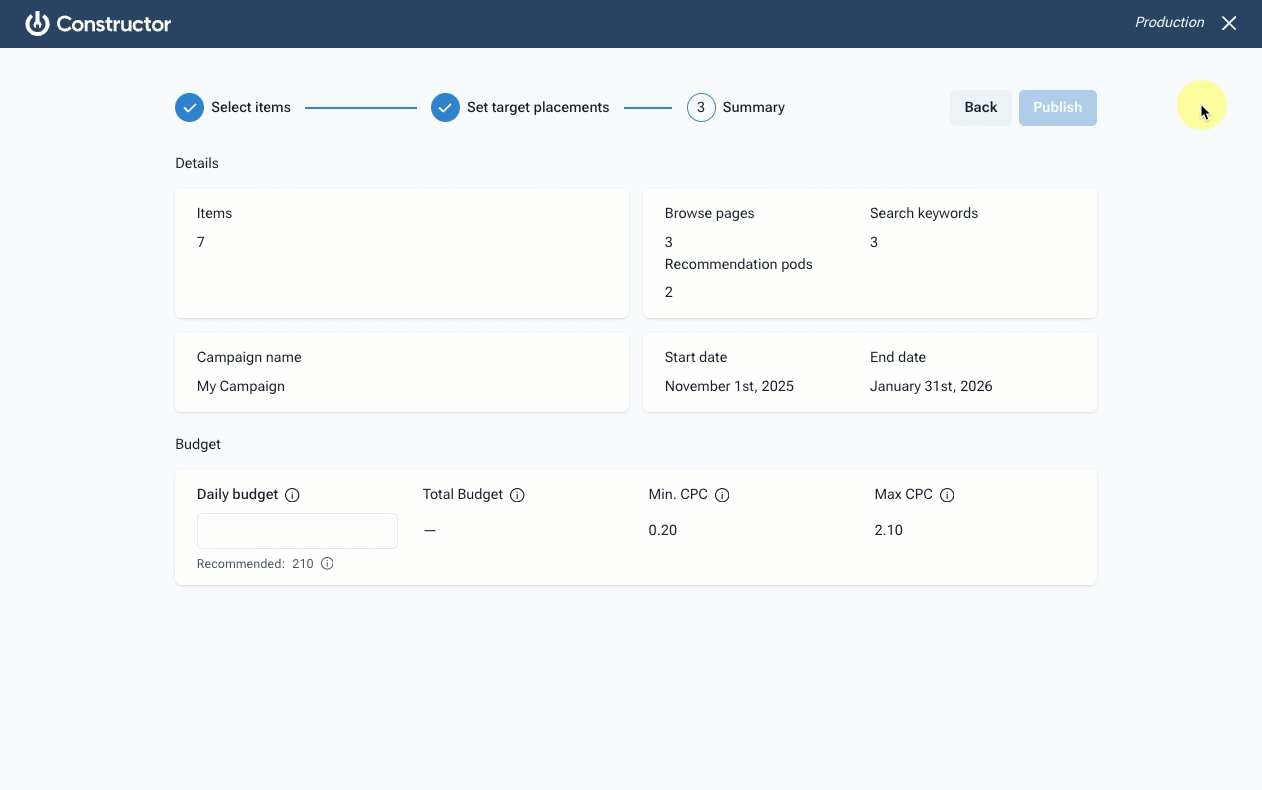
- Review the campaign details listed in the Details section at the top of the page. If you need to make changes, select the Back button in the top-right corner of the page.
- In the Budget section, enter your Daily budget in the field provided. The Total budget to the right of the field will adjust to reflect the total budget across the campaign date range you defined.
- Note: If you are creating a campaign without a fixed end date, then you will see a Monthly budget.
What if my daily budget is below the recommendation?The system provides a recommended daily budget estimation to keep your campaign competitive and help ensure your items stay visible even if other advertisers increase their bids.
You can always choose to follow the recommended minimum bid or adjust it according to your campaign goals and budget.
Updated 6 days ago